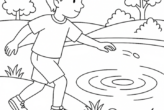Heal Invisible Wounds with Coloring Therapy – A Guide for PTSD Sufferers
By Best Coloring PagesNovember 27th 2017
Art therapy activities – such as coloring – are considered to be highly beneficial to individuals of all ages and all backgrounds, including those who experience emotional disabilities, cognitive disabilities, and physical disabilities.
If you are reading this, it is quite likely that you have suffered through a traumatic event that shocked you, scared you, and was potentially dangerous and have been diagnosed with post-traumatic stress disorder (PTSD). Most people will naturally overcome the symptoms that occur as a result of exposure to trauma; however, there are many that continue to experience complications and may feel high levels of stress, anxiety, and fear even after a danger has passed and no other threats are eminent. These individuals are diagnosed with PTSD. While medication, talk therapy, and other forms of therapy may help an individual overcome PTSD, coloring therapy is the newest and most productive methods for healing invisible wounds.
PTSD – At a Glance
As a PTSD sufferer, you are likely familiar with the fact that it is a psychiatric-based disorder that stems from an exposure to a traumatic event. Situations such as abuse, neglect, exposure to war, and observing violence leave behind memories and feelings that stick. When a sufferer is exposed to a trigger, they may experience a vast array of symptoms and reactions that result in their re-living the trauma. These may include anxiety, become extremely defensive, experiencing lapses in memory and judgment, dissociating from reality, and even emotional numbness. To successfully recover from PTSD, one must work through these traumatic memories until they get to the point where they no longer result in symptoms. Talk therapy, medication therapy, and behavioral therapy may help to desensitize a sufferer, but, it is often not enough. As a result, many professionals are starting to utilize art therapy – such as coloring – to help PTSD sufferers.
Coloring Therapy
Coloring therapy is a form of art therapy. Generally speaking, art therapy utilizes several creative mediums such as drawing, sketching, coloring, painting, and/or sculpting in order to help PTSD sufferers process the traumatic events that they have experienced in a new and more positive way. Coloring therapy is a means of providing an artistic outlet to PTSD sufferers when words are not enough. Sufferers may examine the unique thoughts and feelings that they have about traumatic experiences that have occurred in their life by coloring a feeling and then discussing it with a professional. Coloring therapy is a very powerful way to create a type of separation from a highly terrifying experience. It makes the thoughts, the emotions, and the memories of the experience visible when words are simply not enough.
Recovery
PTSD recovery is possible. It is the act of reclaiming safety over the emotions, the cognitive functioning, and the body. It is common for people with this illness to feel a strong disconnect from their body, their mind, and the world in which they reside. Coloring therapy aids in helping people reconnect with themselves. In fact, this is the most critical component of success when it comes to PTSD recovery. If you are ready to start reconnecting and recovering, we offer a variety of free coloring pages that may help you in your coloring therapy regimen. Simply click the following link to access these pages now: https://www.bestcoloringpagesforkids.com/
Resources:
https://www.ptsd.va.gov/public/PTSD-overview/basics/what-is-ptsd.asp
http://www.sciencedirect.com/science/article/pii/S0197455608001081
http://coloringforfun.com/how-coloring-is-helping-people-overcome-ptsd/




